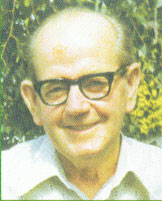About Bowenwork

Tom Bowen
Bowenwork (also called Bowtech and the Original Bowen Technique) is named after Australian, Thomas Ambrose Bowen (1916-1982). He was a self-taught osteopath, unassuming and humble, and said his insights were a gift from God. He began developing his technique in the early 1940’s and continued refining his work until shortly before his death. Massage therapist Ozzie Rentsch was one of six men who observed Tom Bowen at work. Bowenwork is Mr. Rentsch's interpretation of Mr. Bowen's work after observing him for 2 and 1/2 years. There are over 50,000 practitioners worldwide. Read More...
Bowenwork activates your body's innate healing capacity and has a rebalancing and harmonizing effect on all systems of the body, helping to regulate the immune system whether it is overactive or underactive. You may come in specifically for back pain and find that your digestive problems have improved, or that your sleep is more restorative and your mood uplifted. Clients often report noticeable improvement in seemingly unrelated problems they had forgotten to mention to me.
Bowenwork balances the autonomic nervous system. Often the ANS is "stuck" in sympathetic mode dominance. While sleeping your ANS is supposed to be dominated by the parasympathetic mode so that detoxification and healing can take place. That is why a side-effect of Bowenwork is deep, rejuvenating sleep.
It is a non-invasive, soft-tissue technique that resets dysfunctional tension patterns in the body. No oil or lotion is used and often can be done over light clothing. Bowenwork consists of precise "moves" which are done over muscles, tendons, ligaments and nerve bundles. After a certain number of moves I leave the room for at least 2 minutes to allow the brain to process and respond to this new input. The treatment is most effective if I do the minimum. If I do too much the body won't respond optimally.
The gentleness of the moves belies its potential to effect profound, long-lasting change. It has been referred to as the homeopathy of bodywork, meaning the smallest of interventions results in a maximum response, following the "less is more" philosophy. Instead of beating the muscle into submission which might effect a temporary change, Bowenwork asks the body to recognize and make the changes necessary to restore function, bringing it back to homeostasis for longer lasting results.
Bowenwork does require active participation from the client, in that you may be asked to do simple daily exercises and possibly a home remedy. Bowenwork requires that you refrain from all other therapeutic treatments such as massage, acupuncture, chiropractic care, physical therapy and hot/cold packs.
Some conditions resolve after one treatment, most take between 3-6 treatments, while long-standing, chronic conditions could take longer. It is recommended that treatments be spaced 5-10 days apart.
How I Have Benefited From Bowenwork
Bowenwork has helped reduce my symptoms from lyme disease, which include insomnia, pain in my neck, back and legs, headaches, constipation, and chronic fatigue syndrome. It also helped the chronic pain from a broken tailbone, and jaw pain after dental work.
Is Bowenwork for You?
- For those looking for pain relief, stress relief and injury rehabilitation.
- If you have not been helped by more conventional approaches.
- As part of your health maintenance routine and to maintain and/or restore your sense of wellbeing.
- For Athletes, to optimize performance and reduce chance of injuries.
- If you have tried massage and found it did not work for you or if you have a low pain threshold.
- If you are trying to avoid orthopedic surgery. I've treated 5 clients who were told by an orthopedic doctor that surgery was their only option (hip replacement, shoulder, and 2 knees). After Bowenwork sessions they were asymptomatic.
Bowenwork can help with:
- insomnia
- pain syndromes
- autoimmune diseases
- all chronic & acute problems
- menstrual & hormonal irregularities
- sprains/strains
- migraines, headaches
- sciatica
- tailbone injuries
- torn rotator cuff
- frozen shoulder
- plantar fasciitis
- TMJ syndrome
- tinnitus
- Bell's palsy
- vertigo
- sinusitis
- digestive issues
- respiratory issues
- depression
- anxiety
- chronic fatigue
- fibromyalgia
For children:
- bedwetting
- hyperactivity
For babies:
- neck restriction (torticollis)
- colic
- respiratory disorders
- difficulty latching-on when nursing
- unusual fussiness